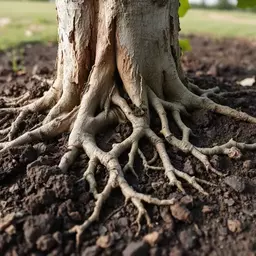
- Root Care
- Aug 05
2025-04-03
Understanding the intricacies of tree health can be a game-changer for any gardener. With root rot lurking in the shadows, knowing how to combat this silent killer is essential for preserving the beauty and longevity of your trees.
Understanding the causes, symptoms, and proactive measures for root rot can significantly impact tree health.
Root rot is a serious condition that can affect the health of trees, often leading to their decline or even death. This disease occurs when the roots of a tree become waterlogged and infected by fungi, depriving them of the oxygen they need to thrive. At Deep Roots Journal, we believe that understanding root rot is crucial for every gardening enthusiast and horticulturist keen on maintaining a vibrant ecosystem.
When we think about the life of a tree, we must consider its roots as the foundation of its health. Root rot can significantly weaken trees, making them more susceptible to pests and diseases. With my experience and passion for horticulture, I have seen how addressing root health can lead to flourishing trees, rooted in a deeper appreciation for their needs.
Root rot is primarily caused by a variety of soil-borne pathogens that thrive in overly moist conditions. As the roots decay, the tree struggles to absorb nutrients and water, leading to stunted growth and other symptoms. It's essential to recognize that not all fungi are harmful; some play a vital role in soil health, but when conditions are right for pathogens, they can wreak havoc! Understanding the causes of root rot is the first step in essential tree care and landscaping.
Root rot is a plant disease where the roots decay due to fungal or bacterial infection, often exacerbated by overly moist soil conditions.
The main causes include overwatering, poor soil drainage, and the presence of certain fungal pathogens in the soil.
Signs include wilting or yellowing leaves, stunted growth, branch dieback, and the presence of mushrooms near the base of the tree.
Preventative measures include ensuring proper soil drainage, avoiding overwatering, and using well-aerated soil.
In some cases, root rot can be treated by improving drainage, applying fungicides, and removing affected roots. Early detection is key to successful treatment. Consulting with a certified arborist is recommended.
Addressing root rot is essential for ensuring that trees can live long, healthy lives. When we take action early, we can save trees from declining health and premature death. By understanding the significance of root care, we can foster a thriving environment for our trees, which in turn supports the wider ecosystem.
At Deep Roots Journal, we emphasize the importance of being proactive. Regularly inspecting trees for signs of distress allows you to catch potential issues before they escalate. Whether it's making adjustments to watering practices or improving soil drainage, small changes can lead to significant results in tree health! Consider how encouraging healthy root development can influence the overall health of your trees.
Did you know? Regularly aerating your soil can significantly improve drainage and reduce the risk of root rot. Using a garden fork or aeration tool, create small holes in the soil around the base of your trees to allow air and moisture to penetrate deeper.
As we wrap up our discussion on root rot, it’s essential to highlight the critical aspects we’ve covered. Understanding the symptoms, causes, and prevention techniques can significantly impact your tree’s health. By staying vigilant for signs like leaf wilt and thinning canopies, you're already on the right path to maintaining a thriving garden!
To recap, the key symptoms of root rot include:
Knowing the causes, such as poor drainage, compacted soil, and certain soil fungi, is just as vital. By recognizing these elements, you can take action before the issue escalates. Remember, the health of your trees starts with you! For information about selecting trees for your garden, that can thrive in your local conditions, read more here.
At Deep Roots Journal, we believe that a proactive approach to tree care cannot be overstated. Regular inspections can help you catch any potential issues before they turn into major problems. Think of your trees as living, breathing entities that thrive with attention and care!
Here are some proactive steps you can take:
By actively monitoring your trees, you'll not only ensure their longevity but also foster a deeper appreciation for the intricate relationships between trees and their soil environments. Trust me, taking a little time to nurture your trees pays off immensely in the long run!
Now that you’re equipped with the knowledge of root rot, it’s time to take action! Protecting your trees is not just about being reactive; it’s about being proactive and intentional. So, what steps can you take today to ensure your trees remain healthy and robust?
Here are some immediate actions you can implement in your gardening routine:
Each step helps create a healthier environment for your trees, making them less susceptible to root rot and other diseases. Remember, small consistent efforts lead to big results!
Sometimes, despite our best efforts, professional help is needed. If you suspect that root rot has taken hold of your trees, don’t hesitate to reach out to an arborist. They have the expertise to diagnose and treat complex issues that might be beyond our knowledge. If you want to create more sustainable landscapes, consider native trees for sustainable landscapes.
When choosing an arborist, consider:
By partnering with an experienced arborist, you can ensure your trees receive the best possible care, enhancing their health and longevity. Let’s work together to protect our natural environments one tree at a time!
Here is a quick recap of the important points discussed in the article:
